
It has been almost exactly a year since I last took a sunset picture from the train just before pulling into La Junta.
I like this one.

The official Sweetie of Muddled Ramblings and Half-Baked Ideas has a heart the size of a planet. She monitors the web site of the shelter across the street to see if there is a neglected dog with special needs, that no one would ever adopt. She bonds with those dogs, sight unseen, because she is empathetic and she wants all living things to be happy.
Winston, honestly, sounded pretty dire. Half of his legs didn’t work. His mobility was forever impaired (spoiler… I just took a break from typing this to have a very kinetic funtime with that poor immobile guy), and he had other issues as well. His weight was listed at 10 pounds, which made him an ideal subordinate for Lady Byng, our dog in residence.
It has not worked out that way, but for the best of reasons. Winston has put on some weight, he can run (if you ignore the occasional face-plant as effortlessly as he does), and he loves people. Big dogs, not so much.
He is a people-pleasin’ bundle of fun, and it breaks my heart that he and Lady Byng don’t get along. But that’s the way in the canine world.

Can you seriously say no to this guy? No, you cannot.
He has some special needs: he has seizures, but Official Sources to Muddled Ramblings and Half-Baked Ideas assert that while they are really effin’ scary for the humans who love him, that he should be OK.
He also hates big dogs. I blame the other dogs for being too big.
Winston loves to play, and in that photo you see Rope. He has Rope. You do not. You want to tug about it? He is ready to tug.
Someone out there needs Winston in their life. Please, for the sake of everyone, help us find that person.
Oh, dang! I forgot to tell y’all how to meet and/or adopt the little guy. To spread the word to your friends, https://www.instagram.com/whataboutwinston_sj/ is his very own instagram account filled with more amazing pics of Winston, along with the contact details with the shelter. Spread this far and wide!
Seriously, whatever you are doing now, stop that and share that link wherever you do social stuff.
If you’re all fired up and ready to meet him yourself, this link will get you to Winston, with all his details.
I love a good chile relleno. But even in New Mexico, the experience of a truly great relleno is rare. Much of the time it’s all cheese and fryer-grease and does not celebrate the magic of the chile itself. What you want to taste is the chile, with a supporting cast. Not just some greasy cheese bomb.
I have been thinking about this for a long time. Thinking that I could put a little grace note on a few hundred years of tradition. I thought (and actually still think) that I can make the best relleno ever.
Where I grew up, the chile relleno was the measure of the restaurant. Easy to make a good one, brutally difficult to make a great one. I worked in the pizza biz.
Recently I found myself at a farmers market and there on a table presided over by a friendly family were some big, fat poblano peppers, gentle and capacious, just begging to be stuffed. Suddenly I declared, “I will make chile rellenos.” I chose two poblanos and found soft cheese at another stall, and my fate was sealed. I would be cooking beyond my ability.
I started with a definition of goals:
Huh. Sometimes you start making a list only to realize there is only one thing on it. For a long time I have imagined the perfect relleno: a magnificent pepper, stuffed with cheese and whatnot, and fried in a light, crackly, tempura batter.
Then came the air fryer, and the hope of a newer, even more awesome relleno was born. I am not a chef. I am not someone you should take food advice from, unless it’s about over-easy eggs, but I have some things to say about chile rellenos.
I made air-fried chile rellenos with a fun (not)-meat and cheese stuffing, in a tempura batter. It was an adventure, and mistakes were made. Lessons learned, and whatnot. The result was not the best relleno I ever ate (not even close!), but it carried with it the promise of being the best.
First step: roast and peel the peppers. The classic method is to roast them over open flame until the skin blackens, then peel. There’s no open flame in our kitchen, but the air fryer (or a convection oven) is an excellent tool for this job. After a few minutes on maximum heat, I pulled them out and put them in a bowl sealed with cling film to let them sweat for fifteen minutes. The outer peel was ready to jump right off!

While they were sweating, so was I. I didn’t just want cheese in the stuffing. I loves me some cheese, but good food needs balance. My support crew set me up with some Impossible meat — it acts a lot like beef, but is made from plants. I browned that up and seasoned it gently with paprika and a little cayenne. I accidentally nailed the seasoning; the spice was subtle and slow.
The soft cheese we got at the farmer’s market was also excellent. It was time to stuff some peppers!

I probably should not have cut the peppers all the way open like that, even though I saw instructions online that did it that way. Or maybe I just put in too much filling. Is that a thing? Anyway, some big ol’ chunks of cheese and the seasoned meat and it was time to (air) fry.
I had also read that you don’t mix up tempura batter until right before you are ready to use it.
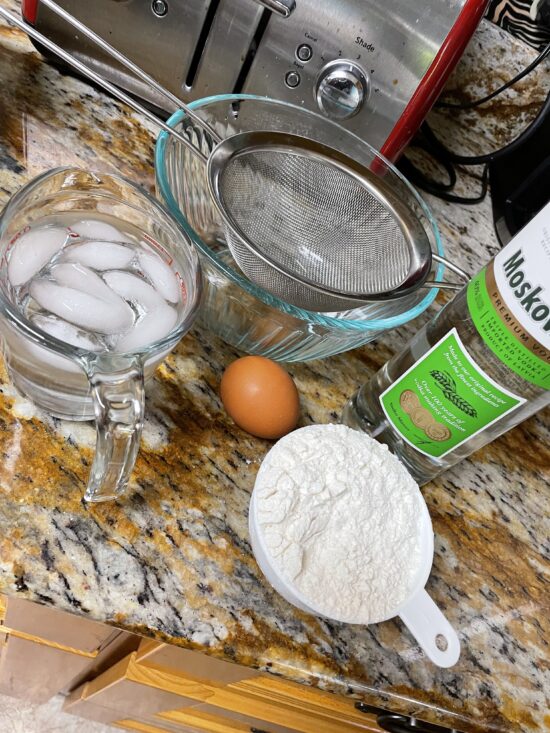
The thing about tempura, apparently, is keeping the gluten from getting all worked up. There are a lot of strategies for this: use flour with less gluten, keep the water cold, and substitute vodka for some of the water.
This is where I made my biggest mistake. The instructions clearly said to whip the egg in the bowl before adding all the other stuff. I did not do that. My sources also said that I should make sure not to overbeat the mixture after the flour was added. Gluten again. I was too shy about getting in there and whipping the egg into the mix after the fact of my mistake, so my “batter” was runny and the egg was not fully integrated.
I dipped my peppers into the mix and not much stuck. A bit did, though, so I laid them incision-up in the air fryer. Meanwhile, my coach went to work on the batter and got it closer to the proper consistency. There was no getting the peppers out and re-dipping, though, so I periodically spooned more batter on top of the peppers as they cooked.
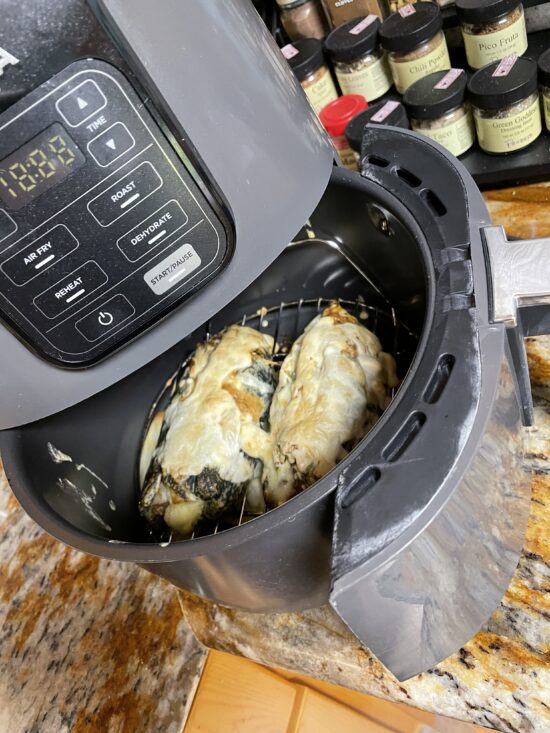
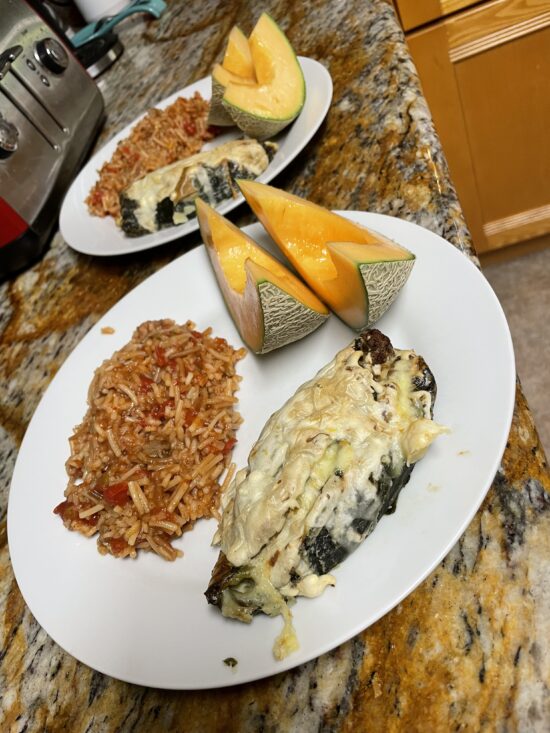
They were… not the greatest chile rellinos ever. The first disappointment was the pepper itself — too sweet! Not much spice at all. They were tasty, but not the vehicles for a savory dish. The blobs of cheese didn’t get as melty as I would have liked. That is probably due to the very large volume of the peppers; it takes a long time to get up to temperature in the middle. The batter… well, you see it up there. I’ll get that better next time.
They were also, by a long, long way, not the worst chile rellinos I have ever had, and quite possibly they were the healthiest. I got close enough to my ideal to validate it, even if I wasn’t actually that close.
The Official Sweetie of Muddled Ramblings and Half-Baked Ideas declared them the best she had ever had. They were also the first she had ever had. My top ranking has held up, however, in comparison to rellinos we got at a restaurant, though our criticism of the professional food diverged.
Tases diverge, and that’s awesome. I once postulated opening a chile-rellino-focussed restaurant that would allow the patron to choose the pepper (hot to mild, different flavors), the filling, and the batter from lists of options. I would choose a hotter pepper than OSMRHBI, but we would both choose a filling with seasoned not-meat to accompany the cheese. BRAIN FLASH! JUST RIGHT NOW AS I WAS TYPING! Use those lovely sweet poblanos for dessert rellinos!
After all these years it still seems like an excellent way to get poor quickly. Even better if someone else runs it and I just get to eat there.

I have said more than once that we need to fundamentally change the way wealth is distributed in our society. I am not the first to say it, and I won’t be the last. Workers produce more and more, and the workforce as a whole is harmed by that trend. All the wealth they are creating goes into the pockets of a few at the top.
In the 1930’s, as banks failed and people lost access to food and shelter, many movements came up with ways to solve the problems that unfettered capitalism had fomented. Socialism and Communism gained in popularity, along with Fascism, which had a bit of a heyday not long after. In the mix were also some more wackadoodle ideas like Technocracy.
Technocracy is named more like a government system, but is mostly about economics. Based on the assumption of continued increases in worker productivity, the response is a very healthy “if people are more productive, they don’t need to spend so many hours producing.” So far, so good!
There is no money in the Technocratic State. Periodically each person is given a certain number of credits. They are not transferrable, and expire. When you go to the store and buy something, the credits you spend are not transferred to the vendor, they simply cease to exist. Shortages and surpluses are not the vendor’s problem.
Prices are controlled by the state, based on the energy required to create the thing. However that would work.
Before I get to some of the more wackadoodle parts, let me mention a couple of less-bad things about Technocracy. The credit distribution is essentially Basic Universal Income; everyone gets what they need. There are no billionaires; no one-percent. Wealth cannot be accumulated; all credits expire. Increased productivity means more for everyone, and more leisure time. Basing the pricing on energy consumed means that the environmental cost of the full lifecycle of an item can be built into the price.
I wrote once (I would include a link but I can’t find it… this blog is big!) that if you could make the cost of purchase of a widget include the cost of mitigating the environmental impact of producing, shipping, using, and disposing of it, there would be no need for any other environmental regulation. Products that pollute less will cost less.
In that same episode I pointed out that such a system was impossible to implement. The government would have to determine the environmental harm tax on every damn thing. The government would have to be swift, efficient, and not subject to second-guessing.
Technocracy solves that problem by getting rid of Democracy along with money. Instead, dispassionate, unbiased engineers would run the show. In this particular autocracy, decisions about the economy would be made by people who recognize that without money the economy is just a machine. They would make the best choices because they are smart and not swayed by greed or politics. They are engineers, dammit, immune to the frailties of humans.
Edison and his ilk were heroes back then; these were the people who should be running things!
Get your chuckles in now; things might turn scary later.
Let’s not even get into how innovation happens in this environment — presumably the engineers in charge will be able to judge every idea and allocate the appropriate resources, with the sole goal to increase worker productivity balanced against energy cost (and state security) further.
One of the core tenets of currency is fungibility. Any dollar is worth the same as any other dollar. All dollars are interchangeable, so they can just as well be numbers in a bank’s computer. The technocrat’s credits are non-fungible: they each are unique and limited in utility and duration. The techno-cretids are, quire literally, non-fungible tokens, or, as the kids say, NFT’s. Put that in your pocket for a minute.
Anyway, no money. Which makes it hard to deal with any economy that still uses money. The answer from the Technocracy proponents was (is?) simply this: don’t. Even back in the 1930’s this was already a stupid and unworkable idea, but the Technocracy proponents wanted to create an absolutely isolated nation that had all it needed, and was surrounded by physical and military walls. No trade, no tourism, no diplomacy.
This proposed nation involved the United States annexing Canada, Greenland, and Central America at least as far as the Panama Canal; preferably further.
Huh. That’s an interesting list, these days. Greenland?
Something else that is interesting: Elon Musk’s grandfather was an active proponent of this nonsense back in the day.
Perhaps it is coincidence that Orange Julius Caesar wants to annex Greenland and take back the Panama Canal. But seriously, Greenland? Perhaps the shift toward isolationism in our diplomacy is not simple stupidity, but stupidity informed by a larger, even stupider goal.
We can be damn certain that OJC loves being rich, but maybe that just means Elon hasn’t told him the whole plan yet. More likely Elon and OJC have built into their plans a way to be far more equal than everyone else in the new regime – they will preserve the billionaire class.
Maybe you’ve already thought of this, but that hypothetical council of wise, unbiased engineers that is supposed to run things? Elon has already fired them. In his drug-addled brain, our new overlord will be AI. Programmed by Elon and his bros, carefully trained to advantage Elon and his bros.
You would have to be seriously high all the time to think something like that could work, but… Elon. He’s already trying his fizzy-brained best to replace at least some of our government with generative AI. If you credit him with having enough brain to form an endgame, replacing money with NFT’s and government with an AI he controls seems like a good candidate.
Am I saying that Elon Musk is a drug-addled idiot eager to adapt the overt racism of one side of his family and the elitist ideals of both to use his wealth to compel a simpering sycophant president to create a world to his liking? Am I saying that the current President of the United States is the simpering sycophant mentioned above, and who like a starving dog will follow any plan as long as it leads to personal profit?
No. Clearly I am not saying that.
When mechanized industry began to replace agriculture, the United States adopted a policy no other country on the planet had considered: mandatory high school.
The results were profound. Industry in the United States had a pool of skilled labor that made our nation THE place to get shit done. My home nation handled this transition so spectacularly well that we became a world power. Other nations insulated the working class from access to education, and paid the economic price.
Up to now, there has been in this nation a general belief that school is good. Sure, there are the special schools accessible only to the wealthy, that don’t actually teach anything special but allow the wealthy to form their own elitist clubs and stack the Supreme Court, but in this country, and ONLY in this country, there are high-quality schools for everyone else.
Name any discipline, and eight of the top ten universities in the world will be in the United States. Seven of those will be state-sponsored universities.
Kids around the world dream of studying in an American university. It is so easy for us to take for granted that we have a sprawling complex of high-quality state schools, that when our current government moves to undermine them that it slips aside. We don’t protest because what is proposed is so absurd we must not have heard it right. Only an idiot would undermine this massive advantage.
That executive order hamstringing the NIH is about a government agency, and not about our schools, right? You know the answer. Defunding science is defunding our future.
MAGA hates education. We haven’t reached “shoot anyone with glasses” yet, and won’t for a while, but we must recognize that the current regime is actively anti-education, actively anti-knowledge, and actively anti-thought. Actively anti-American.
Education was a big part of what made America great. It is hard for people like you and me to understand why so many of our electorate now resent people who have been to school. But that resentment is real, and we have to deal with it. The obvious answer is to increase access to school for everyone. Not necessarily college, but technical or trade or just the skills to run a small business. Anyone who can’t find a job should be able to learn a new job.
School should be available to everyone in this country, without regard to age or history. Schools should be a center for meaningful research. Schools should now be exercising their voices to protest their own emasculation.
So here’s me shouting. I’m shouting for the people who don’t have skills to get a good job, who are tipping the political scales because they don’t. They are not stupid, or lazy. But they have been taught to resent the intellectuals, and therefore to shun any action they might make that might make them an intellectual in the eyes of their neighbors.
More school for everyone. More free school for everyone. Let’s remember what really made America great.
A story about a young snow reporter headed for greatness: Special Vermont Resistance Edition
A country music video with Willie and some glam guy singin’ about how it’s OK to be queer: https://www.youtube.com/watch?v=BirJMnMcfBs
Carry on, comrades.
Filed to: Apple Maps
Summary:
Gulf of Mexico shows as some weird “Gulf of America”
Steps To Reproduce:
Results:
It has a bizarre name applied by fiat by a bunch of cretins.
Regression:
No regression; the name has been the same for 400 years.
Notes:
This is an act of cowardice, and is utterly shameful.
After I submitted the bug report, I had to give a reason to be given access to follow its progress. I wrote: “I would like to see the progress of this bug, as it is the result of shameful weakness in the face of arbitrary fiat. Not even legislative fiat, just one idiot making a proclamation.”
Edit to add: here’s a really good analysis of why it is right for Apple and Google to comply with the rename, but why the way they did so is also wrong: Golfo del Gringo Loco. The article also touches on why the AP must rise to a different standard, which they have, to the peevishment of our leader-in-chuff.
Mom died a couple of weeks ago. I thought I had more time, to be honest. When I left Los Alamos after the new year, all signs were positive. I am fortunate, I suppose, that my last moments with mom were when she was peaking for the last time. She sat next to me as I surveyed the Risk board on the folding table in front of me. The table is probably older than I am, and my no-good nephews allied to eliminate me. It was like we were playing Diplomacy.
But Mom was there, at my left elbow, and happy. Dad was to her left.
For mom, hospitality was unconscious and automatic. There was always room at the dinner table for one more. One of my friends, one of fuego’s friends, or some random Russian scientist with nowhere to go on thanksgiving.
Ask Alexi (the Russian previously mentioned) what Makes America Great, and he will tell you. He will speak of turkey and stuffing, but he will also speak of the welcome of strangers. He will tell you that people like Mom make America great. And he’s right.
I took it for granted when I was a kid that I could drop a friend in around the table. This welcoming attitude cannot be undersold today.
There are many, many other things that made Mom awesome, and I didn’t even know some of them until helping to compose her obituary. She was valedictorian at her high school, and went to Rice University on scholarship. While there, she met my dad on a blind date. They were married for 65 years.
There is a photo of Mom, taken by Dad on the rocks above El Paso, TX. It’s a slide in a box somewhere, I hope. I only saw it once, Mom in blue jeans turned up at the cuff, the wind blowing her hair, the sun in her eyes. Seeing that picture showed me a version of Mom before me; a photo that could have been in a fashion magazine.
I didn’t really understand it then, but a photo like that is a partnership between subject and photographer. Between Mom and Dad.
I’m drifting here. Not sure which stories to tell. But if you knew her, you have your own. She was fierce, and gentle. She was kind. So kind, she was baffled by the unkindness let loose in our country recently. She was tireless helping others, particularly others with special challenges.
Perhaps that started when her family took in a “problem child”. He was seven and didn’t even have the alphabet. Mom took Uncle Dupes under her wing and with infinite patience taught him his letters, and then his words, and Dupes’ life was rescued.
She never stopped doing that.
I think I’ll end with that. Not enough people make the world better; few have the impact she did. But for all I’m proud of that, that was Barbara Seeger, awesome person. But for me she was Mom.
Mom, whom I puked on God knows how many times, who watched God knows how many terrible student plays (You’re a good man, Charlie Brown adapted for the bicentennial an obvious exception), who somehow sensed a critical moment to send me an articulate pep talk from a thousand miles away, is gone now, and I will miss her.
Flags are at half-mast today, recognizing the passing of the greatest former president this country has known.
He was a politician from the South, and he was not perfect. His wife Rosalyn snapped him back to the path of righteousness, and he never forgot that.
His presidency was marred by his desire to do what was best for the little guy. He wanted working people to have good lives. A doomed enterprise from the start. But when his presidency was torpedoed by Ronald Reagan illegally negotiating with the Iranians (seriously, it was a flagrant disregard of our laws), he was forced from the presidency and in that moment he found true greatness.
It is probably not possible to count the number of homes people live in now that he personally helped build. It is not possible to measure the effect Jimmy Carter had on democracy in other nations as an election observer.
Jimmy Carter deserves his rest now. There will not be another like him in US Politics, and more’s the shame, even if he proved why someone like him should not be president.
Like you, I am watching the destruction of our nation happen in real time. Trump could simply put stupid people in charge of our government, but he has to go one further and put stupid people uniquely antagonistic toward their mission in charge of our government.
RFK Jr is a spineless idiot whose only contribution to humanity is the death of 83 people. Actually, that’s just one campaign, it’s pretty clear he has killed many more.
And that’s only the start. We have a QAnon queen in charge of Intelligence. Even the name of the department should disqualify her! She is a puppet of Russia and if I were an intelligence asset in that country I’d be grabbing my go-bag about now. Boebert is so goddam stupid it makes my head hurt.
Oh, and hey, let’s put a sexual predator (and Trump sexual predation enabler) in charge of the department of justice! Why the fuck not? You know this guy will put the law first.
Donald Trump is a stupid man. Really fucking stupid. He honestly doesn’t understand how important his job is. Sure he knows that it makes him a really big deal, but he has no idea at all that there is responsibility that goes with that.
Meanwhile, over in Mother Russia, Vladimir Putin is laughing his ass off. Ukraine is now his. His right to poison dissidents will not be questioned. And all he had to give up were a few flattering words to a little toadstool.
A little over a year ago I started chemotherapy. I haven’t talked about it much around here, but not because nothing happened. I just wasn’t ready yet.
Before the chemo even began, I resigned myself to losing my hair and decided to shave my head rather than leave it lying around all over the place as I shed. I left the beard for the moment. It wasn’t a bad look!
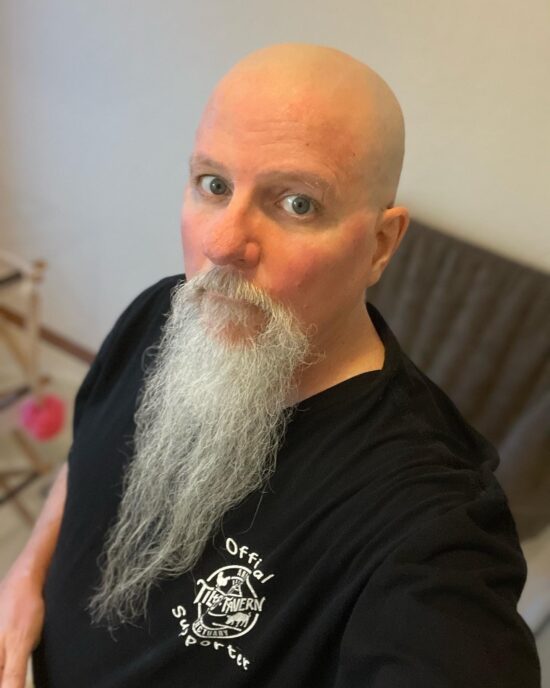
The only problem was that some of the worst people in these Unites States have coopted this look. Here I am the morning of the first chemo treatment, in the bathroom at the cancer center, rocking a special shirt with tearaway sleeves:
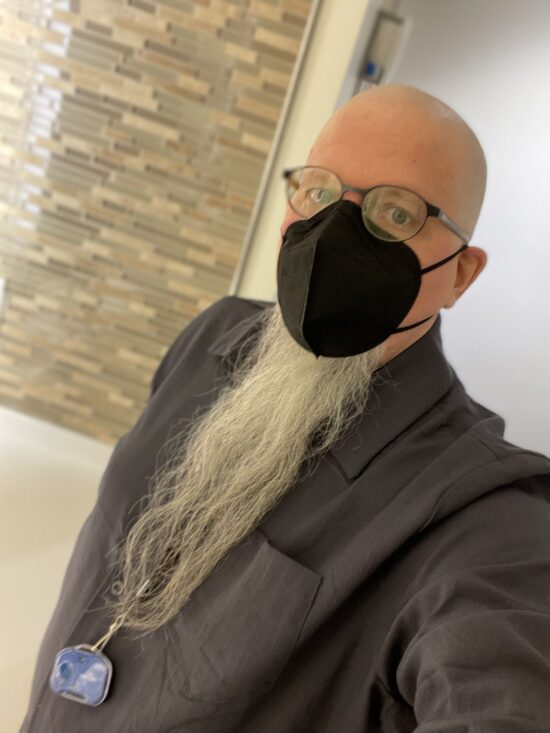
Not long after I took that selfie I sat in a comfortable chair, while the Official Sweetie of Muddled Ramblings and Half-Baked Ideas wrapped my extremities in ice packs. This is me, while we waited for the pharmacist to dole out the drugs:

When the medicine arrived, the tech had to put on special single-use hazardous materials gear before touching it. That stuff is dangerous! God forbid it should get on anything before being injected directly into my blood.
I had already been admonished not to share a bathroom with anyone for a few days, for the same reason. I’m sure the city water treatment plants are well-prepared for stuff like this coming down the pipes. (That was sarcasm.)
The precursor drugs all tucked neatly into my bloodstream, the main event began. The tech hung the bag with the cancer-killer goo, pushed some buttons on the transfusion machine, and made sure we knew where the call button was. We were left alone, to watch the drip.
Only it wasn’t very long I started to feel a little tightness in my chest. “I feel tight in the chest,” I said, “Can you…?” was as far as I got before Official Sweetie was pushing the call button. I felt my head taken by a wave of heat. We were right by the nurse station, and they glanced up and suddenly there was a lot of activity around me.
I was red. Alas fair reader, there is no photographic record of my redness; it was not the time for snapping pics. I have since been compared to the classic Kitchenaid red. If you don’t spend time around quality appliances, that is a very deep red.
I was very quickly surrounded by people. The drip was stopped, and the administration of antihistamines began. I’m a little vague on the details of this period. I did not see the tool box set up behind me with a variety of tools for resuscitating critically ill people, but Official Sweetie did.
While a nurse engaged in conversation with me, which was both pleasant and obviously to measure my mental state, more vitals were taken, my heart was listened to and my lungs were evaluated, and eventually the medical professionals around me decided it was ok to start the drip again, but really slowly. My chair would not be ready for the next patient for a while.
The drip had not been going very long when I reacted again, though not as strongly. MY vote was to try again another day with a different medicine, but my vote was worth exactly zero. One way or another, they were going to get that goo inside me.
Each attempt to put the drug in a person is called a “challenge.” Out of curiosity I asked how many times they would try to give me the meds before they gave up. The answer was technically four, but it sounded like the last challenge would go on a week if it had to.
More intravenous Benadryl, a slower drip yet, and on the third try I didn’t react. Eventually they increased the flow to merely slow, and three hours later than planned we were done.
The chemo medicine takes a while to make you truly miserable, so I drove us home. The megadose of Benadryl did not make me even slightly drowsy. I seem to have a special relationship with that drug. In fact, I’m convinced that I’m a little bit allergic to it, but I won’t bother you with my analysis here.
Home. We got there, and I felt all right, but Official Sweetie and I both knew rough times were coming. But those rough times are different for everyone, which makes preparation more difficult.
Maybe sometime soon I will talk about that. It’s been a year, after all.